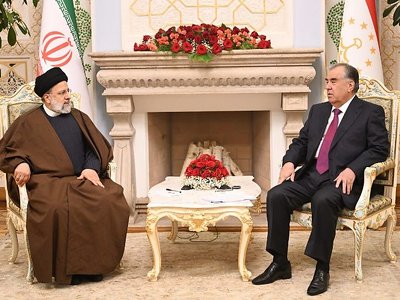A Tajik-Iranian reset: a seaport accord and visa-free travel plans

The Iranian leader’s official visit to Dushanbe and announcement of plans for joint transport projects and visa-free travel signal a major reset of Iranian-Tajik relations.
Until 2015, Tajikistan, the only Persian-speaking nation in Central Asia, was eagerly expanding relations with Iran, seeing it as a ‘natural’ counterweight to Russia’s influence.
However, the ties sharply deteriorated after Tehran accused Tajik banks of helping Iranian businessman Babak Zanjani to steal Iranian oil money, and after the Iranian government invited exiled Tajik opposition leader Muhiddin Kabiri to a conference in Tehran in 2015. The Tajik government went as far as to accuse Iran of meddling in its internal affairs.
Russia’s increasingly open imperialistic rhetoric, even prior to its invasion of Ukraine, has put former Soviet republics on guard in the past few years.
While the four other Turkic-speaking Central Asian nations have pursued closer ties with Turkey, Tajikistan has decided to mend its relations with Iran.
For Iran, Tajikistan is a place where it can establish a foothold with an eye on the rest of resource-rich Central Asia. For landlocked Central Asia, Iran could provide the most convenient access to the sea, if cooperation with Tehran were not complicated by its conflict with the West.
In May 2022, three months after Russia invaded Ukraine, Tajik President Emomali Rahmon visited Tehran.
On 8 November Iranian President Ebrahim Raisi paid a return visit to Dushanbe.
Welcoming Raisi, Rahmon said Tajikistan and Iran were “friendly countries” which had “plenty of opportunities” to expand cooperation.
As part of Raisi’s visit, the two countries signed 19 cooperation accords.
One of them was a memorandum on Tajikistan’s use of the Iranian sea port of Chabahar, which is located in southeastern Iran — on the Gulf of Oman — and could give direct access to the Indian Ocean to the Central Asian nations.
According to the Tajik Transport Ministry, the sides have agreed on simplifying the use of the port by Tajik companies (making it cheaper and faster); on working jointly to promote the use of Chabahar by other countries to give access to other inland trade routes crossing Central Asia; supporting infrastructure projects that would facilitate the use of Chabahar; and working to improve the safety and efficiency of shipments through Chabahar.
The countries have agreed to set up a special committee to work out all the necessary aspects and draft a final agreement on Chabahar.
India has long been showing an interest in using Chabahar for trade with Central Asia. In 2015, India and Iran signed an accord on joint development of the port.
An expansion of trade through Chabahar could help Iran develop its poorer eastern regions. It is planning to create a free trade zone around the port and establish reliable railway and motorway routes linking it to Central Asia.
It could also ease the burden on Iran’s Persian Gulf port Bandar Abbas, which accounts for 85 percent of Iran’s sea shipments. Also, because of the shallow waters at Bandar Abbas, the port cannot service big cargo ships.
Tajikistan does not share a border with Iran and would have to get to it via Uzbekistan and Turkmenistan. The shortest route would be via Afghanistan but this is currently not feasible.
There are also ideas to establish a railway link between Chabahar and the oil-rich Caspian Sea across Turkmenistan and Kazakhstan.
Raisi’s visit also resulted in the signing of a memorandum on plans to introduce visa-free travel between Tajikistan and Iran.
- Последние
- Популярные
Новости по дням
4 мая 2024







